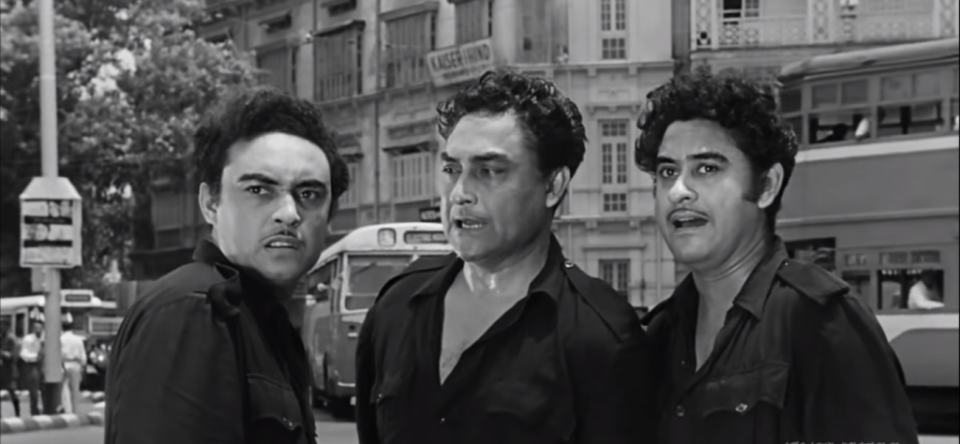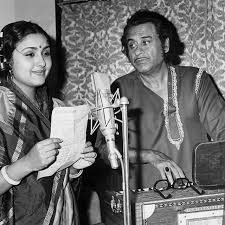'This is a lunatic asylum’: Curious case of Kishore Kumar
Producer, director, writer, composer, singer, actor… the late Kishore Kumar was all of that and more.
On his 33rd death anniversary, we curate zany titbits about him.
“He was not mad. He had a naqaab on…he enjoyed it. He’d say, ‘Duniya mujhe kehti pagal, main kehta duniya ko pagal’!” son/singer Amit Kumar once summed up his late father’s maverick personality.

What’s genius if not eccentric!
Read on to know the curious case of Kishore Kumar.
Kishore Kumar was the youngest of four siblings, the older three being actors Ashok Kumar and Anoop Kumar and Sati Devi. Superstar Ashok Kumar often threw parties at his Worli residence. Young Kishore, who didn’t drink and was unaffected by the glamour, would go to the Haji Ali parapet and sleep the night off.

Kishore’s first love was filmmaking. He had an 8mm camera with which he filmed mundane moments. He shot son Amit Kumar’s growing years and made two volumes of it. He shot the entire train journey from Kolkata to Darjeeling where he shot Madh Bhare Nain (1955) with Bina Rai.
Kishore had a great collection of James Bond and Alfred Hitchcock films and Hollywood classics. The Grapes Of Wrath (1940) and How Green Was My Valley (1941) were his favourites. Gary Cooper was his favourite actor and Marlon Brando his idol.
Once he visited a video shack in Hollywood and bought VCDs worth 8000 dollars. The owner came to understand his famous identity. Just then Eddie Murphy came along. The shack owner introduced Kishore to him as the ‘Frank Sinatra of India’.

Tales of Kishore’s eccentricities abound.
Outside his house was written, ‘This is a lunatic asylum’.
On another instance, he put make-up on just half of his face for a producer, who’d only paid him half his fee.
Reportedly, in the early ’70s, he grew his hair long and wore sadhu-like robes with a beaded mala. He began calling himself Swami Kishore Anand. He even attended recordings in this attire.
Later, he went around blindfolded. “Mujhe kisiko nahin dekhna. Looking at each other invokes jealousy,” he reportedly said.
Then one day, he apparently took off to Badrinath in those robes. Once when he was sitting on a peak there, some women pilgrims asked who the sadhu was. His associate Robin Kumar replied he was Swami Kishore Anand. The women went up to touch his feet. But one of them recognised him as the famous singer and screamed, “Yeh to Kishore Kumar hai!”
Kishore never visited a barber. He trimmed his own hair by placing three mirrors around him. He was an early riser and went to bed early. He loved authentic Bengali food like puri tarkari, aloo gobi, mutton curry, katla mach and hilsa curry.
When Kishore was recording the Bangla song Ei To Jiban (film Amar Kantak), written by noted poet Gauri Prasan Majumdar, he was visibly moved. The philosophic song underlined that all violence and hostility perish on the funeral pyre. He refused to charge a fee for the song.
Once he happened to hear Mukesh’s song, Aa ab laut chalein (Jis Desh Mein Ganga Behti Hai), on radio. He began sobbing like a baby and told his family he wanted to return to Khandwa.
Kishore was a rustic at heart.
Kishore Kumar liked sitting in a cemetery. Once he was sitting in one in Goa, when he saw a name plate on a padre’s grave, which read ‘Died on August 4 1929 (Kishore’s birthday)’. From that day onwards he started calling himself Father Brown saying, ‘I was a padre in my previous life’
Few know that Kishore had a strong spiritual side.
He was fascinated with the word ‘door (far in Hindi)’ and used it in his trilogy Door Gagan Ki Chaon Mein, Door Ka Rahi and Door Wadiyon Mein Kahin in the ’60s.
He believed in Jesus Christ and was fond of Biblical films.
He liked sitting in a cemetery. Once he was sitting in one in Goa, when he saw a name plate on a padre’s grave, which read ‘Died on August 4 1929 (Kishore’s birthday)’. From that day onwards he started calling himself Father Brown saying, ‘I was a padre in my previous life’.

Kishore didn’t want to marry actor Leena Chandavarkar without seeking her parents’ blessings. He went to Dharwad to convince them. There he sat on a chatai with his harmonium and began singing.
He began from K L Saigal’s Main kya janoon kya jadoo hai (Zindagi), to his own songs Dukhi man mere (Funtoosh), Zindagi ka safar (Safar) and others. Eventually, when he sang Nafrat karne walon ke seene mein pyar bhar doon (Johny Mera Naam), Leena’s reluctant father (Sreenath Chandavarkar) smiled and gave his consent.
(1970s) Kishore Kumar and Amit Kumar at a song recording.@GangulyAmitK pic.twitter.com/tFN624T7Kg
— Film History Pics (@FilmHistoryPic) March 15, 2019
On 13 October 1987, it was Kishore’s day off. During lunch, he told wife Leena that he wanted to watch the film River Of No Return in the evening. A little later, she heard him move furniture in the next room.
Changing the ‘ghar ka naqsha’ was his pet peeve. Just then he complained of chest pain and lay down on the bed. Leena wanted to call the doctor. But he’s said to have stopped her saying in jest, ‘Doctor ko mat bulana warna heart attack aajayega’!
He never spoke after that.
RELATED READS:
'Hail Mogambo!': Fans loved Amrish Puri's 'bad boy' image, but theatre was his first love
'My father loved only his wife': Love, loss and tears with Rima Jain
'What happened that night?': After 28 years, the pain is still raw, says Divya Bharti's parents
'Superstar at 16, dead at 36': Madhubala, the original heartbreak girl



